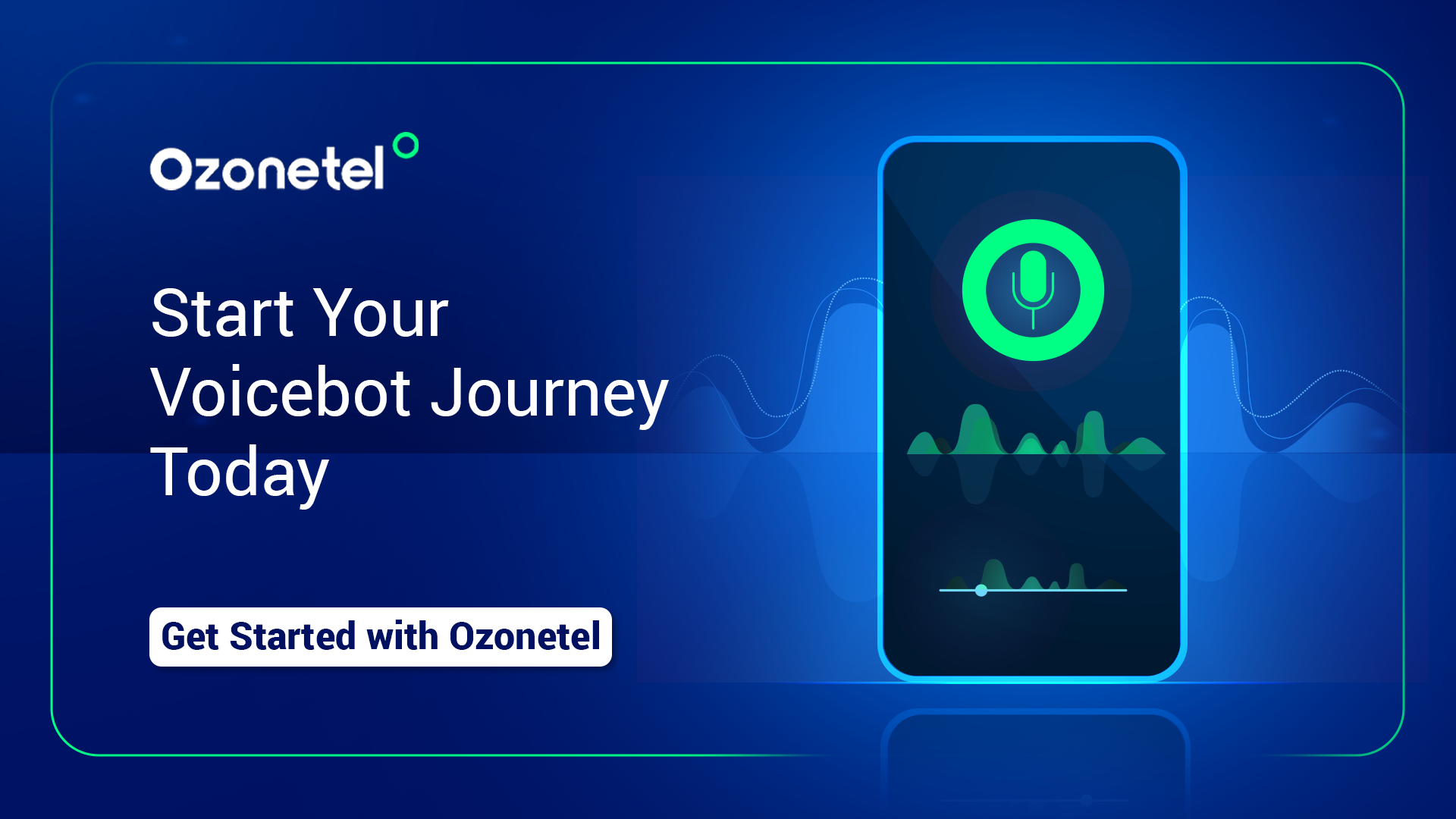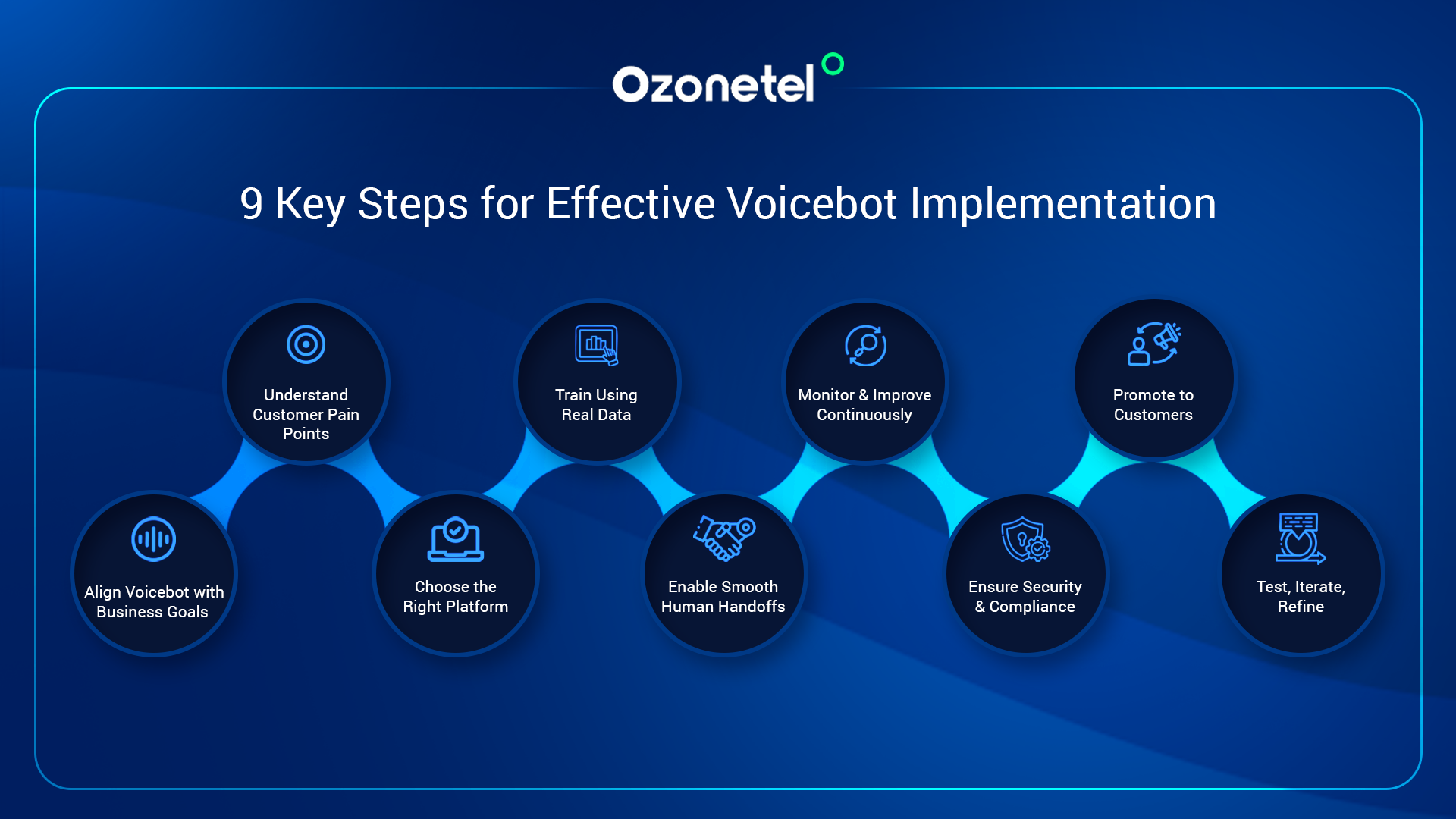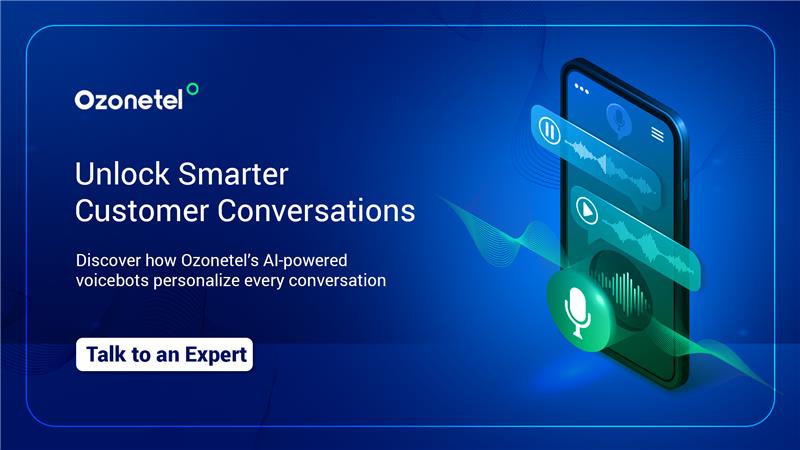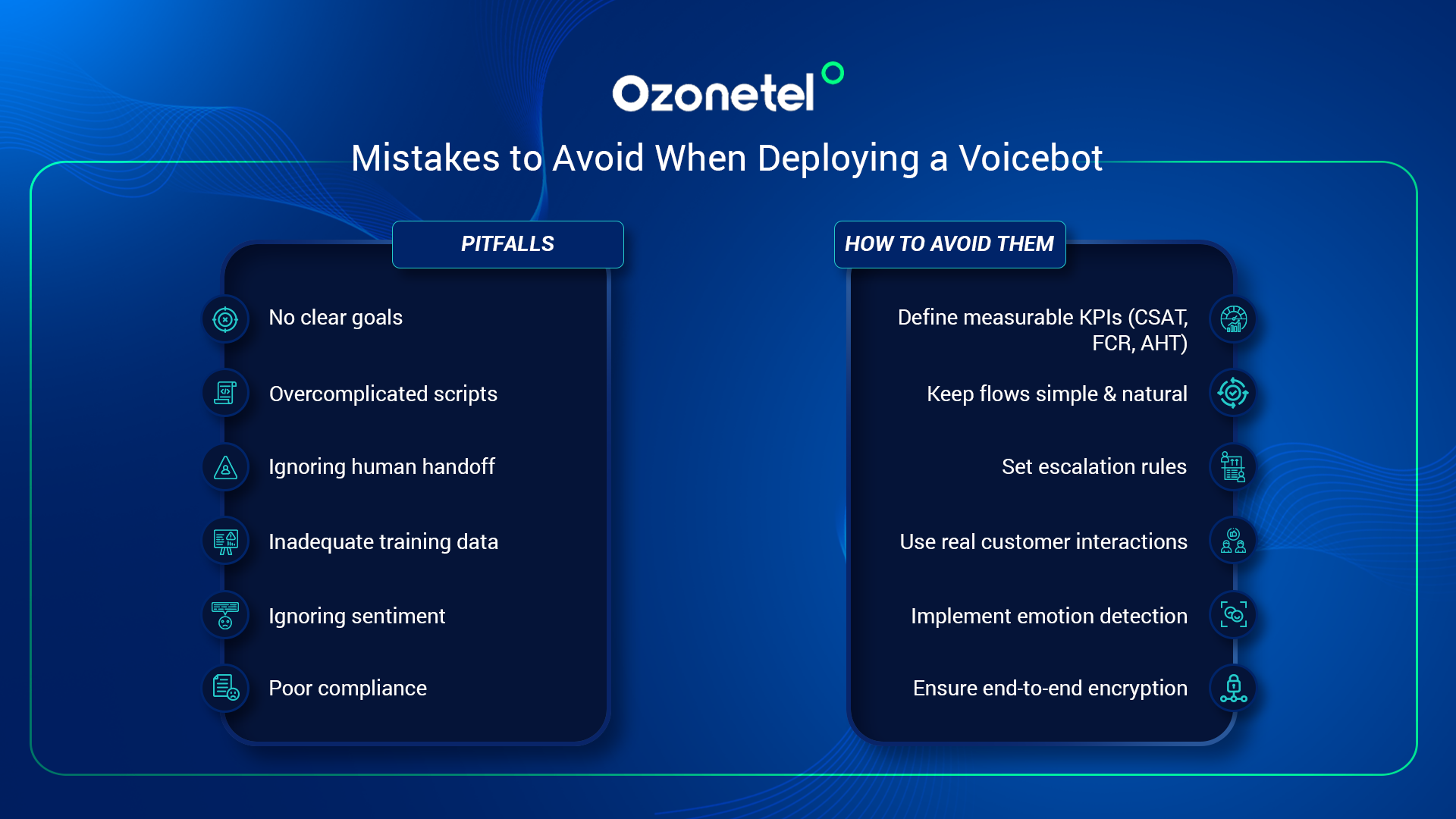- Resources
- How to Implement a Voicebot in Business? Best Practices
How to Implement a Voicebot in Business? Best Practices

As customer expectations rise, businesses are turning to voicebots to keep up with the demand for fast, efficient, and personalized service. These AI-driven assistants not only handle customer inquiries but also provide a touch of human-like interaction that makes each experience feel unique.
With 24/7 availability and the ability to scale effortlessly, voicebots are quickly becoming essential to delivering exceptional customer experiences at every touchpoint. If you’re considering implementing a voicebot in your business, here’s how to do it effectively and ensure it helps you boost customer satisfaction and streamline operations.
What are voicebots?
Voicebots are AI-powered systems designed to automate and manage voice-based interactions. They simulate human conversation, allowing businesses to engage with customers through voice rather than relying on live agents.
Voicebots can handle a variety of tasks, such as answering customer queries, guiding users through processes, or even processing transactions.
Ozonetel Voice Bot Capabilities
Ozonetel’s GenAI-powered Voice Bots enhance CX with intelligent self-service and human-like interactions, enabling faster, smarter, and highly personalized customer experiences.
Speech Recognition – Accurately converts customer speech into text in real time, enabling precise understanding, analysis, and automated action by the system.
Text-to-Speech – Generates natural, dynamic, and human-like voice responses instantly, providing customers with a seamless, interactive, and engaging conversational experience.
Agent Connect – Effortlessly transfers customer conversations to live agents whenever human intervention is needed, ensuring smooth support handoffs and improved satisfaction.
Date Detection – Automatically identifies and extracts dates mentioned by customers in conversations, enabling accurate scheduling, reminders, and follow-up actions without manual effort.
Automated Callback – Schedules and initiates follow-up calls to customers automatically, ensuring no inquiries are missed and enhancing timely engagement.
Natural Language Processing (NLP) – Understands context, intent, and language nuances to deliver intelligent, relevant, and accurate responses during conversations with customers.
Customizable Prompts – Allows businesses to tailor conversational prompts, messages, and tone to align with brand voice and enhance overall customer experience.
API Integrations – Seamlessly connects with external systems such as CRMs, ticketing tools, or ERPs, providing real-time data access for smarter automation.
Automated Surveys & Feedback – Instantly collects customer feedback and opinions through conversations, helping businesses measure satisfaction and continuously improve service quality.
Ideal Practices for Implementing a Voicebot
Implementing a voicebot requires a clear strategy to ensure measurable business impact and long-term value. Here’s a comprehensive guide for effective deployment:

1. Align Voicebot Deployment with Clear Business Goals
Automation without purpose rarely delivers results. Identify business objectives such as improving customer service efficiency, increasing sales, or reducing operational costs.
Define measurable outcomes: for example, track how the voicebot contributes to First-Call Resolution (FCR), Customer Satisfaction (CSAT), or Average Handling Time (AHT).
Example: A real estate company aiming to boost site visits can automate appointment scheduling through the voicebot and measure success by conversion to actual visits.
2. Understand Customer Needs and Pain Points
Map the customer journey to identify where automation adds value. Analyze common queries and repetitive tasks to prioritize areas for the voicebot.
Examples of routine tasks: Checking balances, scheduling appointments, or answering FAQs. Banks, for instance, can automate inquiries about account balances or loan eligibility, freeing human agents for complex tasks.
3. Choose the Right Platform for Integration
Select a platform that supports advanced AI, NLP, and omnichannel engagement while integrating with CRM, ticketing, or ERP systems. Seamless integration ensures a smooth experience for both customers and agents.
Example: Retail businesses can use platforms like Ozonetel to ensure real-time data sharing, allowing agents to take over conversations without losing context.
4. Train the Voicebot Using Real-World Data
Train the bot with past interactions to recognize customer phrasing, tone, and common queries. Include diverse speech patterns, regional accents, and colloquialisms.
Regularly update datasets with new conversations, feedback, and agent insights to improve accuracy.
Example: Financial institutions can train the voicebot to handle loan-related inquiries, enabling confident, context-aware responses over time.
5. Ensure Smooth Handoffs to Human Agents
Voicebots excel at routine tasks, but complex queries require human intervention. Define clear escalation protocols and ensure agents have full context to prevent customer frustration.
Example: In telecom, a billing dispute can be escalated instantly, with the agent receiving all prior interaction details for seamless resolution.
6. Monitor and Continuously Improve Performance
Track key metrics such as CSAT, sentiment analysis, and FCR. Use insights to optimize responses, scripts, and conversation flows continuously.
Example: Analyzing call sentiment trends can reveal areas where the bot struggles, allowing proactive updates to improve customer experience.
7. Ensure Data Security and Compliance
Voicebots must handle sensitive data securely, adhering to regulations like GDPR, HIPAA, or PCI-DSS. Use encrypted communications, secure storage, and audit logs.
Example: Banking voicebots processing financial information must meet compliance standards to maintain trust and avoid legal penalties.
8. Promote the Voicebot to Customers
Customer awareness drives adoption. Communicate the voicebot’s capabilities via email, SMS, or website banners, highlighting benefits such as 24/7 support, reduced wait times, or faster service.
Example: Travel companies can use SMS notifications to encourage customers to interact with the bot for booking updates or flight information.
9. Test, Iterate, and Refine
Voicebot deployment is never “set and forget.” Continuously test performance, gather feedback, and iterate on scripts, AI models, and decision logic.
Example: Retailers can A/B test responses to common sales objections and refine scripts to improve conversion rates over time.
Common Voicebot Pitfalls and How to Avoid Them
Setting up a voicebot can greatly enhance customer service, streamline operations, and improve efficiency. However, several mistakes can hinder its success. Avoiding these common pitfalls will help ensure that your voicebot delivers real value. Here are the key mistakes to avoid.
1. Lack of Clear Objectives
Deploying a voicebot without defined goals can lead to poor performance and missed opportunities.
How to Avoid:
- Define objectives such as reducing handle time, improving CSAT, or automating FAQs.
- Track measurable KPIs like response time, first-call resolution (FCR), and satisfaction scores.
2. Overcomplicating the Script
Complex scripts trying to handle every scenario can confuse both the bot and customers.
How to Avoid:
- Keep scripts simple, focusing on common tasks like checking balances or making reservations.
- Ensure natural, human-like interactions and allow seamless handoff to agents when needed.
3. Neglecting Human Handoff Options
Failing to plan smooth transitions to human agents frustrates customers.
How to Avoid:
- Set clear escalation rules for complex issues.
- Provide agents with full context from prior interactions for seamless support.
4. Inadequate Training Data
Limited or irrelevant data leads to misunderstandings, especially with diverse accents or uncommon phrases.
How to Avoid:
- Train using real customer interactions.
- Continuously update datasets to reflect evolving language and trends.
5. Ignoring Sentiment and Context
Bots that respond identically to all customers can escalate dissatisfaction.
How to Avoid:
- Implement sentiment analysis to detect tone and adjust responses.
- Make the bot context-aware using prior interactions and customer history.
- Underestimating Customer Expectations
Assuming customers will intuitively understand or accept limited bot interactions can drive them away.
How to Avoid:
- Clearly communicate the bot’s capabilities and limitations.
- Ensure quick, accurate responses and offer alternative ways to reach assistance.
7. Failing to Test and Iterate
Launching without thorough testing can lead to errors, miscommunications, and a poor experience.
How to Avoid:
- Test across scenarios, languages, and accents before launch.
- Gather feedback and continuously refine the bot’s performance.
8. Overlooking Compliance and Security
Ignoring regulations or security can risk sensitive customer data and erode trust.
How to Avoid:
- Comply with relevant laws (GDPR, PCI-DSS, HIPAA, etc.).
- Implement end-to-end encryption and conduct regular security audits.
9. Not Providing Clear User Instructions
Customers may abandon interactions if they don’t know how to use the bot.
How to Avoid:
- Provide clear prompts: e.g., “Say ‘check balance’ to know your account balance.”
- Include a brief tutorial or FAQ at the start of interactions.
10. Relying Too Much on Automation
Bots can’t replace empathy or human judgment in complex or sensitive interactions.
How to Avoid:
- Handle routine tasks with the bot but ensure easy access to human agents.
Reserve human intervention for complaints, nuanced queries, or situations requiring empathy.
Why Ozonetel’s Voice AI Agents outperform traditional voice bots
| Aspect | Ozonetel Voice AI Agents | Other Voicebots |
|---|---|---|
| Conversational Ability | Fully conversational with seamless context handling; improves customer experience (CX). | Typically rule-based — phrase recognition and decision trees; limited contextual understanding. |
| Decision-Making | Acts more like a human: suggests best options in complex scenarios and adapts decisions. | Limited to predefined tasks and scripted outcomes; little autonomous decision-making. |
| Language Flexibility | Can switch instantly across 13 Indian languages & dialects (mid-conversation switching supported). | Usually cannot switch languages mid-conversation or supports fewer languages. |
| Empathy & Nuance | Recognizes tone and emotion, responds empathetically to improve engagement. | Rigid; typically lacks emotional understanding and nuance. |
| Conversation Flow | Non-linear, intent-driven flows that enable faster closures and natural interaction. | Linear, goal-limited flows — users often forced down predetermined paths. |
| Voice Quality | Human-like with adjustable pitch/tempo and natural prosody — better customer satisfaction & NPS impact. | Often robotic and monotone; can negatively impact engagement and NPS. |
Use Cases of Ozonetel Voice AI Agents
Ozonetel’s GenAI-powered Voice AI Agents are redefining how businesses connect with customers. Beyond automation, they deliver predictive, personalized, and proactive conversations—driving faster resolutions, higher efficiency, and measurable business impact.
Here’s how leading financial institutions in India are leveraging Voice AI Agents:
1. Loan Repayment Reminders | Leading Rural NBFC
A rural NBFC deployed Voice AI Agents to deliver personalized loan repayment reminders at scale. Using dynamic IVR dialers, each customer received context-aware messages addressing their name and repayment amount.
Key Outcomes:
- 5M personalized reminders delivered every month
- 50% faster turnaround compared to manual calls
- Higher repayment rates with improved customer engagement
2. Personalized Policy Onboarding | Top Insurance Firm
A top insurance firm leveraged AI-powered Voice Bots to welcome new customers, verify KYC details, and collect feedback—automating routine calls while maintaining a personal touch.
Key Outcomes:
- 25,000+ outbound calls in three months
- Real-time sentiment insights to improve customer experience
- Automated KYC & survey data updates in CRM
3. Optimized Gold Loan Collections | Muthoot Gold
Muthoot Gold deployed Voice AI Agents to engage borrowers with contextual repayment reminders, optimizing outreach for its jewelry loan division.
Key Outcomes:
- 43,500 proactive calls in five months
- Lower operational costs with agent reallocation
- 8% increase in collections → direct revenue growth
With Voice AI Agents, enterprises gain more than automation—they unlock intelligent, always-on, and scalable customer conversations that elevate efficiency, boost satisfaction, and fuel growth.
Wrapping Up
Voicebots are revolutionizing the way businesses engage with their customers. By automating routine tasks, providing 24/7 support, and offering personalized experiences, voicebots are helping brands stay competitive in a fast-paced, customer-driven market.
And when it comes to voicebot solutions, Ozonetel is your trusted partner. Our AI-powered voicebots seamlessly integrate with your existing systems to deliver intuitive, personalized customer interactions. Whether you’re in banking, retail, or any other sector, Ozonetel’s voicebots can help you streamline operations, improve customer satisfaction, and ultimately drive business growth.
Schedule a demo today and see how Ozonetel can transform your customer experience with cutting-edge voicebot technology!
Ozonetel helps teams deliver CX faster with lower costs
Frequently Asked Questions
Ozonetel’s cloud-native architecture enables businesses to go live in days—not weeks or months like many traditional enterprise platforms. With minimal IT dependencies and simple API integrations, deployment is frictionless even at scale. In contrast, Genesys implementations often involve complex setup cycles and customization layers that can extend timelines, especially for mid-market or multi-location rollouts.
Ozonetel’s 24/7 customer support is known for its hands-on, personalized approach. During high-traffic periods or service disruptions, businesses often cite Ozonetel’s faster response times and proactive resolution compared to Genesys’ ticket-driven escalation model. The local presence and dedicated success teams make Ozonetel a more agile partner in critical moments.
Genesys offers extensive analytics capabilities, but Ozonetel bridges the gap with real-time dashboards, customizable reports, and AI-powered conversation intelligence. Users gain actionable visibility into agent performance, call quality, and customer sentiment without needing external tools or data teams. Ozonetel’s unified analytics also eliminate silos—something that’s harder to achieve with Genesys’ multi-module architecture.
Ozonetel is built to scale horizontally. Whether it’s a startup expanding across regions or an enterprise managing thousands of concurrent interactions, the platform adapts without costly migrations or infrastructure overhauls. Genesys offers strong scalability too, but with higher costs, licensing complexities, and longer configuration cycles that can slow down agility as you grow.
Genesys has long been associated with advanced automation, but Ozonetel has quickly closed the gap with AI-first tools like conversational intelligence, real-time agent assist, and customer journey automation. What sets Ozonetel apart is accessibility—AI is embedded natively into the platform, making it easier and faster for teams to deploy without external integrations or added costs.








